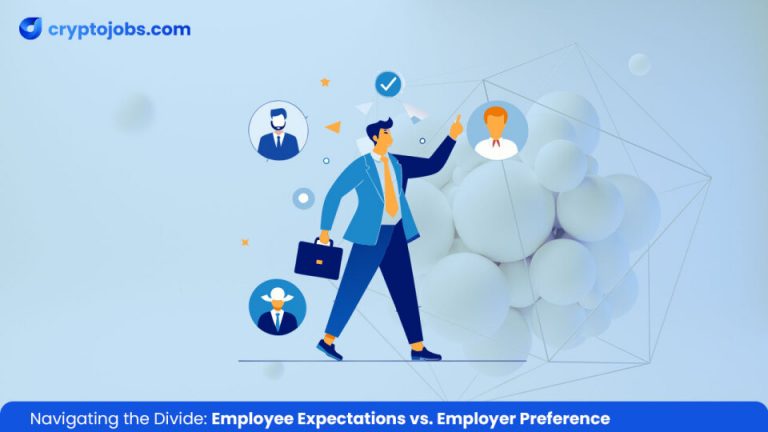
Navigating the Divide: Employee Expectations vs. Employer Preferences
- cryptojobs.com
- September 13, 2024
- All Posts, featured
- 0 Comments
Finding the delicate balance between employee expectations and employer preferences has become infinitely important in this digital age. With the emergence of web3 and blockchain technology, businesses strive to keep up with the new trends and shifting dynamics in the job market to accommodate employees to the best of their abilities. Meanwhile, employees seek ways to boost their productivity without compromising their work-life balance.
Employer preferences and employee expectations must coincide to create a positive and effective work environment. However, there’s often a big disconnect between what employers prioritize and what employees want. Organizations need to comprehend these differences to attract, retain, and motivate top talent.
To help bridge the gap, here are key employer preferences and employee expectations to help you understand both perspectives.
Work-life Balance vs. Availability
Above all, employees prioritize a healthy work-life balance. According to a 2023 report by Randstad, 94% of employees believe work-life balance is important. Subsequently, 87% of employees expect their employers to support them in balancing their work and personal lives. For an employee, this expectation translates into regular working hours and minimum to no disruptions outside of working hours.
For employers, companies expect their employees to be available and responsive for urgent matters, even beyond traditional working hours. This expectation applies to C-level positions or any roles demanding immediate problem-solving.
Note: To overcome this disparity, employees can make themselves available for urgent tasks, while employers can respect the employee’s time and only seek assistance in an emergency.
Career Development vs. Productivity
Another common point of divide between employees and employers is career development/productivity. Talents often look for career development and professional advancement opportunities, recognizing the importance of continuous learning and growth, especially while working in the web3 industry. According to a report by BetterWorks, 86% of employees believe skill development is important to them, but only 54% of them receive it.
On the other hand, companies and employers prefer immediate productivity, seeking employees who can quickly contribute to the goals and project milestones without extensive training. This saves precious time that can be used on project development, product majority, and employee skill development. An employee who can hit the ground running is prioritized while hiring!
Note: To overcome this gap in preferences and expectations, employers can give more room for growth to the employees. Working on developing skills of the employees benefits both the company and the employee in the long run.
Job Security vs. Performance-Based Retention
It goes without saying that employees prefer job security; many view long-term employment as a form of stability. In fact, job satisfaction is closely tied to job security. As long as they meet basic performance criteria, employees expect to remain employed.
However, employers prefer performance-based retention and consider already communicated performance targets and milestones. Annual performance reviews and biannual feedback from reporting managers for contract renewal are often prioritized by employers.
Note: Employees can work smartly to reach performance milestones, while employers can set performance targets and miles after communicating with the employees.
Compensation and Benefits vs. Cost Management
Working in a fast-paced environment such as the web3 industry can be tiring and hectic. Talented individuals working in this industry expect competitive salaries and benefits. 79% of employees quit their jobs due to a lack of appreciation, whereas 73% admitted they would consider leaving their current position for a higher salary. These stats reflect the importance employees place on fair compensation and benefits to maintain financial stability.
Employers, on the other hand, aim to manage costs effectively. They focus on offering competitive compensation for every position to maintain the financial stability of the company. Companies have to consider overhead costs such as utilities, bonuses, wages, and more, making it a tough position for them to meet the expectations of the employees.
Note: In order to reach a middle ground, employees should maintain realistic expectations for compensation packages and bonuses. Similarly, employers must consider alternative compensation methods such as profit-sharing bonuses and compensatory holidays.
Recognition and Appreciation vs. Standardized Evaluation
It is human nature to crave positive feedback and recognition for our hard work. Employees expect recognition and appreciation for their hard work, with 83.6% of employees believing that recognition affects their motivation to succeed at work. 77.9% of employees say they would be more productive if they were recognized more frequently. Subsequently, 79% would leave their jobs if they weren’t appreciated for their hard work. This highlights the importance of acknowledging and valuing employee’s efforts.
Employers frequently rely on standardized evaluation processes, focusing on metrics and data-driven assessments. They prefer structured performance reviews based on predefined criteria and metrics.
Note: Reporting managers should consider recognizing and appreciating employees’ hard work to keep motivating the teams and keep their morale up.
Remote Work Flexibility vs. On-site Presence
The balance between remote work flexibility and onsite presence has become a significant topic of discussion in the modern workplace. Industries such as web3, blockchain, and crypto thrive because remote work made it possible for companies to tap into the global talent pool. Employees increasingly value the convenience and work-life balance that remote work offers, with 72% preferring to work in a hybrid remote/office model.
Many employers prefer the onsite presence of the employees, as sometimes their presence in the office is essential for fostering collaboration, maintaining company culture, and ensuring productivity. In-person interactions can facilitate spontaneous brainstorming, build team synergy, and strengthen company culture.
Note: To address both valid concerns, companies should adopt a hybrid model that combines remote and onsite work to strike a balance between business needs and employee satisfaction.
Final Takeaways
Work expectations are constantly evolving with the dynamic changes in the web3 industry. Employees desire a balance between their financial security, professional development, and personal well-being. On the other hand, employers prioritize cost-effectiveness, productivity, and maintaining a strong company culture. The only way we can bridge this gap is through a collaborative approach. Ultimately, an ideal workplace fosters a sense of mutual respect and understanding. In an ideal workplace, employees feel valued and empowered, and employers can rely on a productive and engaged workforce. By embracing innovative solutions and fostering open communication, organizations can create a work environment that thrives in the ever-changing web3 landscape.




